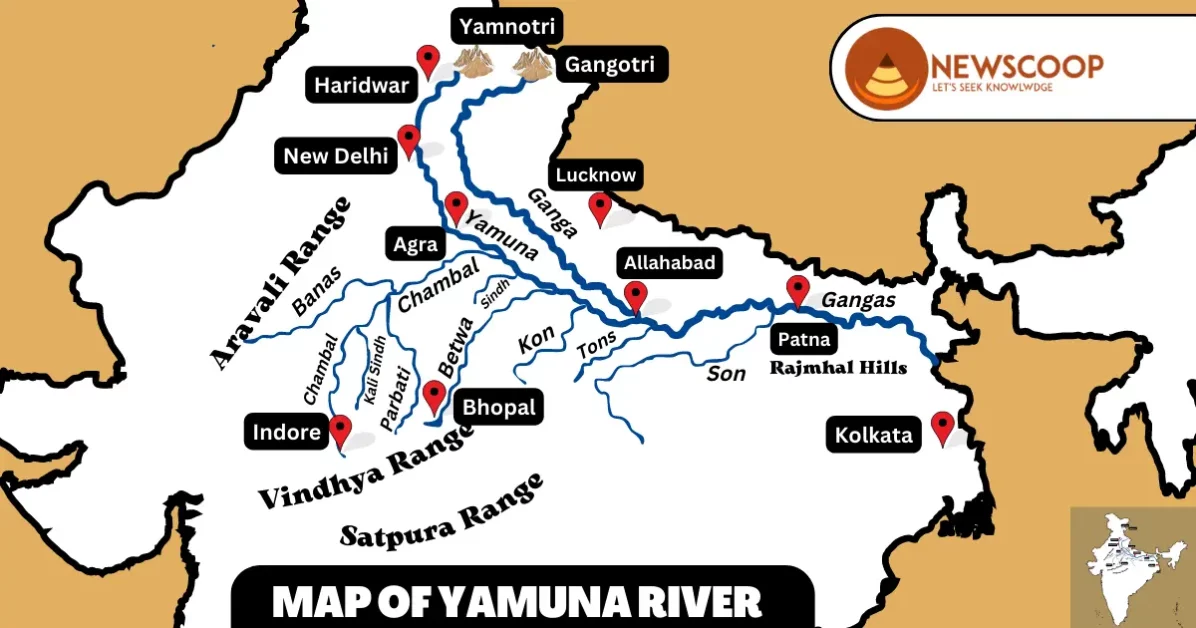The Yamuna River is incredibly important for India, especially Uttar Pradesh. If you are studying for the UPSC exam, it’s crucial to have a good understanding of the Yamuna River. Questions about its geography, environmental problems, and societal impact often come up in the exam.
In this article, we will explore the main features of the Yamuna River, its relevance to UPSC preparation, and the challenges it confronts. We’ll discuss geographical aspects such as its origin, length, and the states it flows through. Additionally, we’ll explore its tributaries, dam projects, cultural significance, and environmental issues.
| Origin | Yamunotri Glacier, Uttarakhand |
| Length | Approx. 1376 km |
| States Flowing Through | Uttarakhand, Himachal Pradesh, Uttar Pradesh, Haryana, Delhi |
| Tributaries | Chambal, Sindh, Betwa, Ken, and others |
| Confluence | Merges with the Ganges at Prayagraj (Allahabad) |
| Major Cities | Delhi, Agra, Mathura, Vrindavan |
| Hydroelectric Projects | Hathnikund Barrage, Okhla Barrage, and others |
Geographical Features of Yamuna River
The following are the physical features of the Yamuna River:
- It originates from the Yamunotri Glacier in Uttarakhand.
- Flows through several states, including Uttarakhand, Himachal Pradesh, Haryana, Delhi, and Uttar Pradesh.
- Meanders through a total length of approximately 1,376 kilometers (855 miles).
- The river passes through a wide and fertile valley known as the Yamuna Valley.
- Forms a wide floodplain as it enters the North Indian Plains, characterized by fertile alluvial soil.
- Varies in width along its course, with narrow stretches and wider sections.
- Has numerous tributaries, including the Tons River, Hindon River, and Chambal River.
- The riverbed varies in depth and composition, influenced by geological factors.
- The Yamuna River plays a significant role in supporting agriculture, industry, tourism, and transportation in the regions it passes through.
- The physical characteristics of the river have shaped the cultural and historical heritage of cities along its banks, such as Delhi, Agra, and Mathura.
Origin and Course
The Yamuna River originates from the Yamunotri Glacier, situated in the lower Himalayas at an altitude of approximately 6,387 meters. This glacier serves as the primary source of the river. Located in Uttarakhand, it marks the beginning of the Yamuna’s journey.
From its origin, the river flows through several states, including Uttarakhand, Himachal Pradesh, Haryana, Delhi, and Uttar Pradesh. It traverses a total length of around 1,376 kilometers (855 miles) before joining the Ganges River in Prayagraj (formerly known as Allahabad). The confluence of the Yamuna and the Ganges is considered a sacred site in Indian culture.
Map of Yamuna River

Cities & Landmarks
Following are the major cities and landmarks along the course of the Yamuna River:
- Yamunotri
- Delhi
- Agra
- Mathura
- Haridwar
- Vrindavan
- Allahabad (Prayagraj)
- Etawah
- Noida
- Faridabad
- Hathras
Tributaries of Yamuna River
Here is a list of major tributaries of the Yamuna River:
- Chambal River
- Sindh River
- Betwa River
- Hindon River
- Ken River
- Tons River
- Giri River
Chambal River
- Chambal River originates from the Vindhya Range near Mhow in Madhya Pradesh, India.
- Flows primarily through Madhya Pradesh and Rajasthan, covering a distance of approximately 1024 kilometers.
- Has several tributaries, including the Banas River, Kali Sindh River, and Parbati River.
- Home to the National Chambal Sanctuary, dedicated to the conservation of endangered species such as the Ganges river dolphin and gharial.
- Rich biodiversity with diverse flora and fauna, including various species of birds, mammals, reptiles, and fish.
- Characterized by extensive ravines, known as the Chambal Valley, creating a unique landscape.
Sindh River
- Originates from the Malwa Plateau in Madhya Pradesh, India.
- Flows through Madhya Pradesh, Uttar Pradesh, and Rajasthan.
- Length of approximately 470 kilometers (290 miles).
- Tributaries include the Parwan River and the Kali Sindh River.
- Supports agricultural activities through irrigation.
Betwa River
- It Originates from the Vindhya Range near Bhopal, Madhya Pradesh.
- Flows through Madhya Pradesh and Uttar Pradesh.
- Length of approximately 590 kilometers (370 miles).
- Tributaries include the Dhasan River and the Jamni River.
- Scenic landscapes with hills, forests, and ravines.
- Rajghat Dam helps in irrigation, hydropower generation, and water supply.
- Hosts the Betwa Wildlife Sanctuary.
Hindon River
- It Originates from the Saharanpur district in the state of Uttarakhand, India.
- Flows through the Indian states of Uttarakhand, Uttar Pradesh, and Haryana.
- Merges with the Yamuna River near Ghaziabad, Uttar Pradesh.
- Length of approximately 400 kilometers (250 miles).
- Tributaries include the Krishni River and the Kali River.
- The Hindon River basin is home to various bird species, making it important for avian conservation.
- Efforts are being made to restore and rejuvenate the Hindon River through conservation projects and awareness campaigns.
Ken River
- The Ken River originates from the hills near Village Ahirgawan in Raisen district, Madhya Pradesh.
- It flows through the states of Madhya Pradesh and Uttar Pradesh.
- The river has a total length of approximately 427 kilometers (265 miles).
- Some of the tributaries of the Ken River include the Sonar River, Simiri River, and Urmil River.
- The Ken River is known for its scenic beauty and pristine surroundings.
- It passes through the Ken River Gorge, which is located near the Panna National Park and offers breathtaking views.
Tons River
- It Originates from the southern slopes of the Tons Glacier in Uttarakhand.
- Flows through Uttarakhand and Himachal Pradesh.
- Length of approximately 322 kilometers (200 miles).
- Tributaries include the Yamuna River and the Supin River.
- Scenic landscapes with deep gorges, dense forests, and remote valleys.
Dams on the Yamuna River
Here is a list of dams on the Yamuna River:
- Tehri Dam
- Lakhwar Dam
- Hathnikund Barrage
- Tajewala Barrage
- Wazirabad Barrage
- Okhla Barrage
- Gokul Barrage
- Vishnuprayag Barrage
- Kishau Dam (proposed)
- Renuka Dam (proposed)
Pollution & Environment Issues
The pollution of the Yamuna River is a significant environmental issue. Here are some key points regarding the pollution of the Yamuna:
- Industrial Pollution: The discharge of untreated industrial effluents into the river is one of the major sources of pollution. Industries located along the riverbank contribute to the contamination of chemicals, heavy metals, and toxins.
- Domestic Sewage: The discharge of untreated domestic sewage and wastewater from cities and towns along the Yamuna is another significant cause of pollution. The inadequate or lack of sewage treatment infrastructure results in the direct release of sewage into the river.
- Solid Waste Dumping: Improper disposal of solid waste, including plastics and other non-biodegradable materials, adds to the pollution of the river. Dumping of garbage directly into the Yamuna or its tributaries further degrades the water quality.
- Agricultural Runoff: The excessive use of fertilizers, pesticides, and herbicides in agriculture leads to the contamination of the river through agricultural runoff. These chemicals can enter the river system during rainfall or irrigation, negatively impacting water quality.
- Riverbank Encroachments: Unregulated encroachments along the riverbank obstruct the natural flow of the river and contribute to its pollution. Unauthorized construction and settlements result in the dumping of waste and untreated sewage directly into the river.
- Impact on Ecosystem: The pollution of the Yamuna River has severe consequences for its ecosystem. It affects aquatic life, depletes oxygen levels, and disrupts the balance of the river’s ecosystem, leading to the decline of fish species and other organisms.
- Health Concerns: The contaminated water of the Yamuna poses health risks to communities living along its banks. The use of polluted water for drinking and daily activities can lead to waterborne diseases and other health problems.
Efforts are being made by the government, environmental organizations, and local communities to address the pollution of the Yamuna River. Initiatives include the establishment of sewage treatment plants, stricter industrial regulations, public awareness campaigns, and river conservation projects.
However, the challenge of tackling Yamuna’s pollution requires sustained efforts and effective implementation of pollution control measures.
Conclusion
In conclusion, the pollution of the Yamuna River is a pressing concern that requires immediate attention and action. Industrial discharge, untreated sewage, and agricultural runoff have significantly impacted the water quality and ecosystem of the river. This pollution not only poses risks to the environment and aquatic life but also affects the health and well-being of communities along its banks.
Efforts should be made to enforce stricter regulations, improve waste management systems, and promote public awareness to restore and preserve the Yamuna River for future generations. By addressing the pollution issues, we can ensure a cleaner and healthier Yamuna River ecosystem for all.
Thank You!
FAQs
What is the length of the Yamuna River?
The length of the Yamuna River is around 1,376 kilometers (855 miles), making it one of the longest rivers in India.
Where does the Yamuna River originate?
The Yamuna River originates from the Yamunotri Glacier, which is located in the Uttarakhand state of India, in the western Himalayas.





